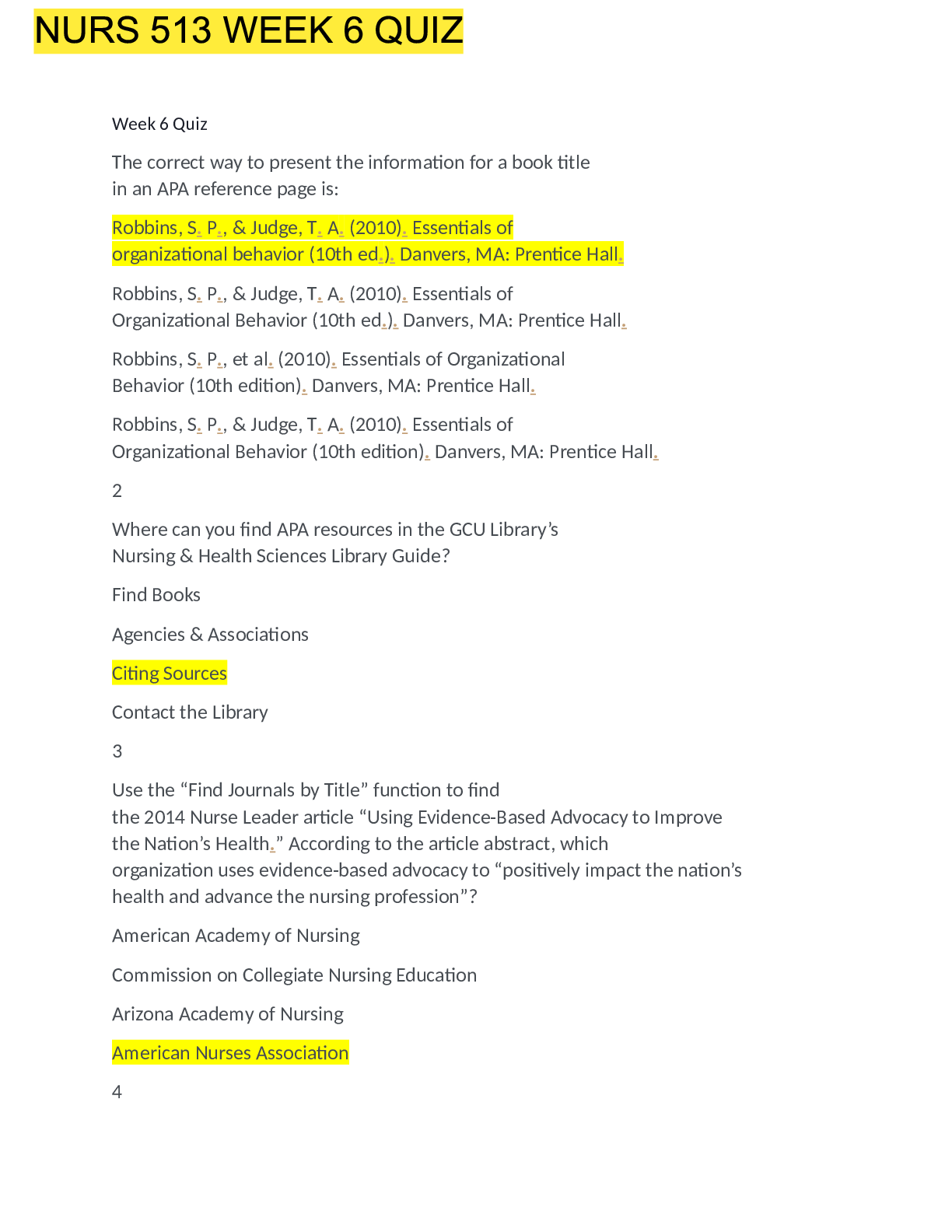*NURSING > EXAM > NURS-6501N Week 4, Advanced Pathophysiology_ WALDEN UNIVERSITY: QUESTION AND ANSWERS RATED A (All)
NURS-6501N Week 4, Advanced Pathophysiology_ WALDEN UNIVERSITY: QUESTION AND ANSWERS RATED A
Document Content and Description Below
• NURS-6501N-Quiz Wk4 • Question 1 0 out of 0 points When completing this quiz, did you comply with Walden University’s Code of Conduct including the expectations for academic integrity? ... • Question 2 1 out of 1 points A nurse monitors the patient for _____ when rapid onset of malignant hypertension results. • Question 3 1 out of 1 points A 65-year-old female presents to the emergency department reporting difficulty swallowing and shortness of breath. A CT scan would most likely reveal an aneurysm in the: • Question 4 1 out of 1 points An 82-year-old female was admitted to the hospital with confusion and severe hypotension. Her body’s compensatory mechanisms are increased heart rate, vasoconstriction, and movement of large volumes of interstitial fluid to the vascular compartment. What kind of shock does the nurse suspect the patient is experiencing? • Question 5 1 out of 1 points A 52-year-old male is diagnosed with primary hypertension. He has no other health problems. Present treatment would cause the nurse to anticipate administering which drug to the patient? • Question 6 1 out of 1 points A 51-year-old male is at the health clinic for an annual physical exam. After walking from the car to the clinic, he developed substernal pain. He also reported discomfort in his left shoulder and his jaw, lasting 2 to 3 minutes and then subsiding with rest. He indicates that this has occurred frequently over the past few months with similar exertion. The nurse suspects he is most likely experiencing: • Question 7 1 out of 1 points A 70-year-old female is in the hospital for pelvic fracture. She develops pulmonary thromboembolism. The nurse realizes this embolus is composed of: • Question 8 1 out of 1 points A 54-year-old male is diagnosed with left bundle branch block. Which of the following structures would not receive an electrical impulse? • Question 9 1 out of 1 points While planning care for a patient with superior vena cava syndrome (SVCS), which principle should the nurse remember? SVCS is a progressive _____ of the superior vena cava (SVC) that leads to venous distention of the upper extremities and head. • Question 10 1 out of 1 points A 50-year-old obese male with hypertension and coronary artery disease visits a nutritionist for food counseling. He has an elevated level of low-density lipoprotein (LDL) and a low level of high-density lipoprotein (HDL). Which of the following should the nurse advise him to avoid? • Question 11 1 out of 1 points A 5-year-old female is found to have hypertension during three separate visits to her primary care provider. The nurse would expect tests to suggest that the hypertension is secondary to: • Question 12 1 out of 1 points A 50-year-old male is diagnosed with pulmonary embolism (PE). Which of the following symptoms most likely occurred before treatment? • Question 13 1 out of 1 points A 59-year-old female is diagnosed with left ventricular failure. If a decrease in kidney perfusion occurs, the nurse knows this would ultimately cause: • Question 14 1 out of 1 points A 62-year-old male presents to his primary care provider reporting chest pain at rest and with exertion. He does not have a history of coronary artery disease and reports that the pain often occurs at night. He is most likely experiencing which type of angina? • Question 15 1 out of 1 points Which organ should the nurse monitor closely since it is often the first to fail in patients with multiple organ dysfunction syndrome (MODS)? • Question 16 1 out of 1 points A 50-year-old male with a 30-year history of smoking was diagnosed with bronchogenic cancer. He developed edema and venous distention in the upper extremities and face. Which of the following diagnosis will the nurse observe on the chart? • Question 17 1 out of 1 points An 80-year-old female is in the hospital for a bone fracture. While there she develops a large, nonlethal pulmonary embolus. Which of the following is a direct result of the obstruction to pulmonary blood flow? • Question 18 1 out of 1 points A 50-year-old male is diagnosed with orthostatic hypotension. Which of the following symptoms would he most likely experience? • Question 19 1 out of 1 points A 68-year-old female is experiencing left heart failure. Physical exam reveals elevated blood pressure. The nurse understands this is most likely caused by: • Question 20 1 out of 1 points A 52-year-old male presents with pooling of blood in the veins of the lower extremities and edema. The diagnosis is chronic venous insufficiency, and an expected assessment finding of this disorder is: • Question 21 1 out of 1 points A 75-year-old female has been critically ill with multiple organ dysfunction syndrome (MODS) for longer than a week and has developed a severe oxygen supply and demand imbalance. The statement that best describes this imbalance is which of the following? • Question 22 1 out of 1 points A 65-year-old male presents for a routine checkup. A blood pressure check reveals a systolic pressure of 160 mm Hg and a diastolic pressure of 70 mm Hg. Which of the following is the most likely cause of this type of pressure elevation? • Question 23 1 out of 1 points A 50-year-old female received trauma to the chest that caused severe impairment of the primary pacemaker cells of the heart. Which of the following areas received the greatest damage? • Question 24 1 out of 1 points Many valvular stenosis and regurgitation disorders in adults have a common etiology. Which of the following conditions should alert the nurse that the patient may have both types of valve dysfunction? • Question 25 1 out of 1 points Which of the following patients is at highest risk for developing pulmonary embolism (PE)? • Question 26 1 out of 1 points Which condition should cause the nurse to assess for high-output failure in a patient? • Question 27 1 out of 1 points A patient wants to know what causes atherosclerosis. How should the nurse respond? In general, atherosclerosis is caused by: • Question 28 1 out of 1 points What term should the nurse document for a detached blood clot? • Question 29 1 out of 1 points When a nurse checks the patient for orthostatic hypotension, what did the nurse have the patient do? • Question 30 1 out of 1 points A 35-year-old male presents with pulmonary hypertension. Testing reveals he is in right heart failure. Which of the following is the most likely diagnosis the nurse will see listed on the chart? • Question 31 1 out of 1 points A 60-year-old male undergoes surgery for a bone fracture. Which of the following nursing measures would be most effective for preventing pulmonary embolism (PE) in this patient? [Show More]
Last updated: 1 year ago
Preview 1 out of 7 pages
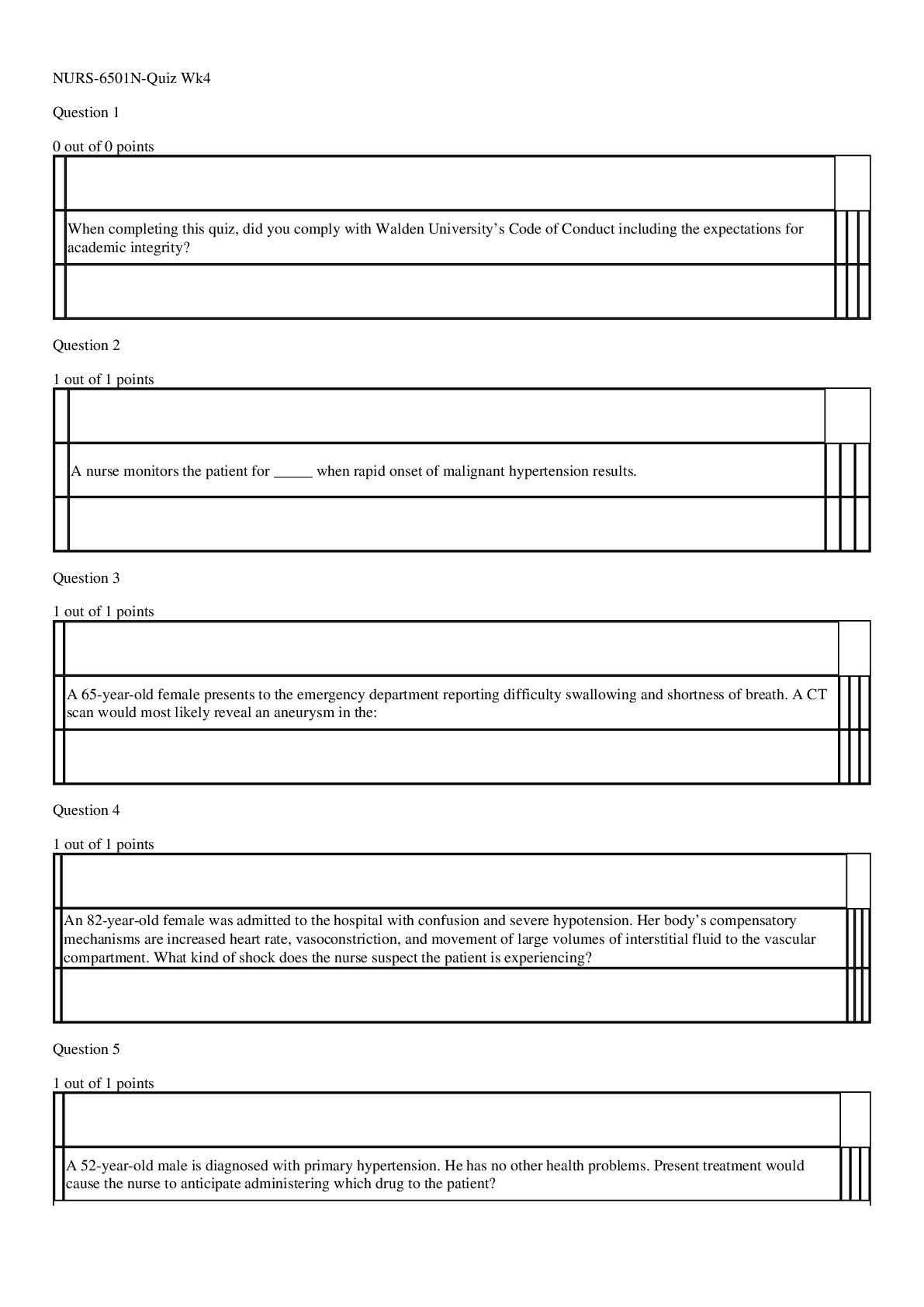
Reviews( 0 )
Document information
Connected school, study & course
About the document
Uploaded On
May 08, 2020
Number of pages
7
Written in
Additional information
This document has been written for:
Uploaded
May 08, 2020
Downloads
0
Views
42


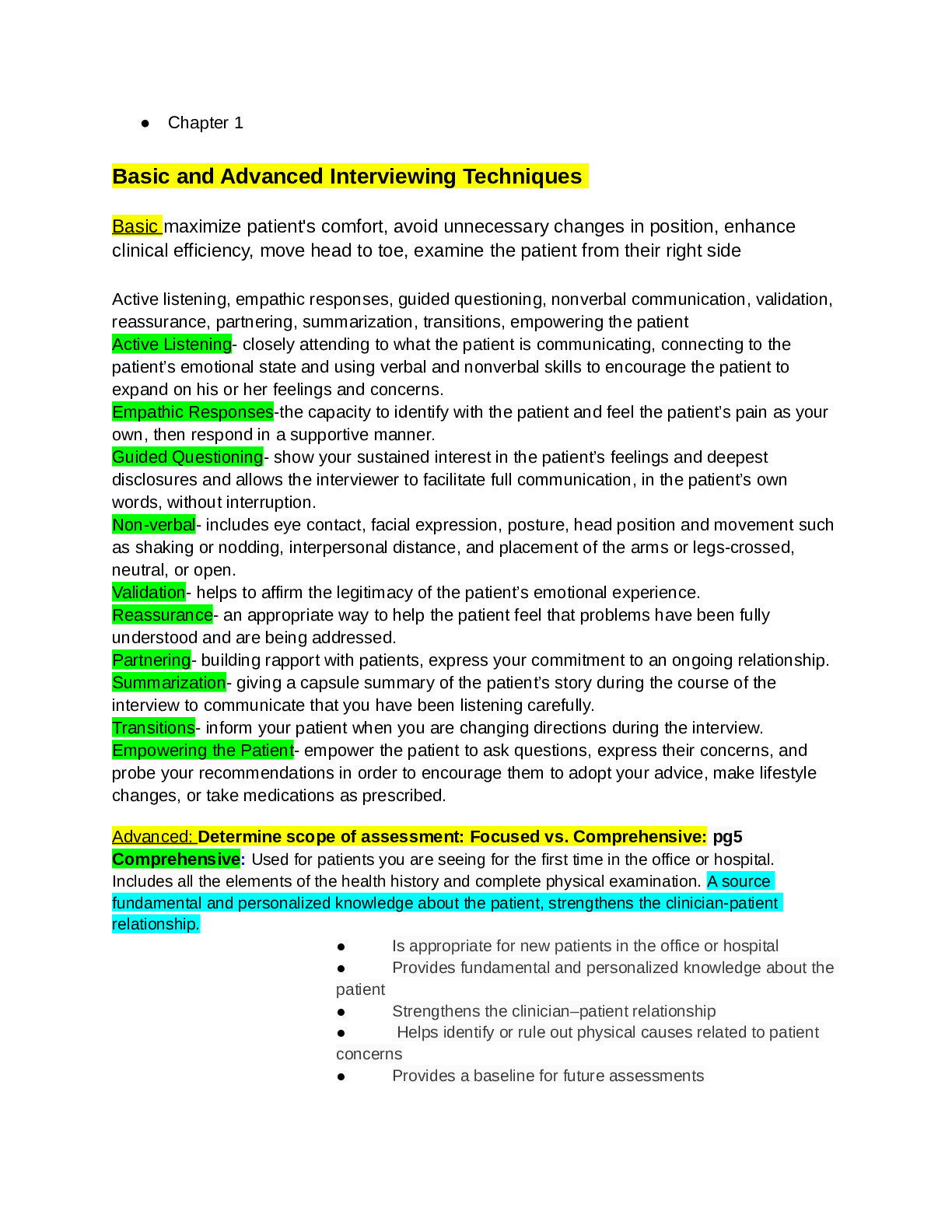
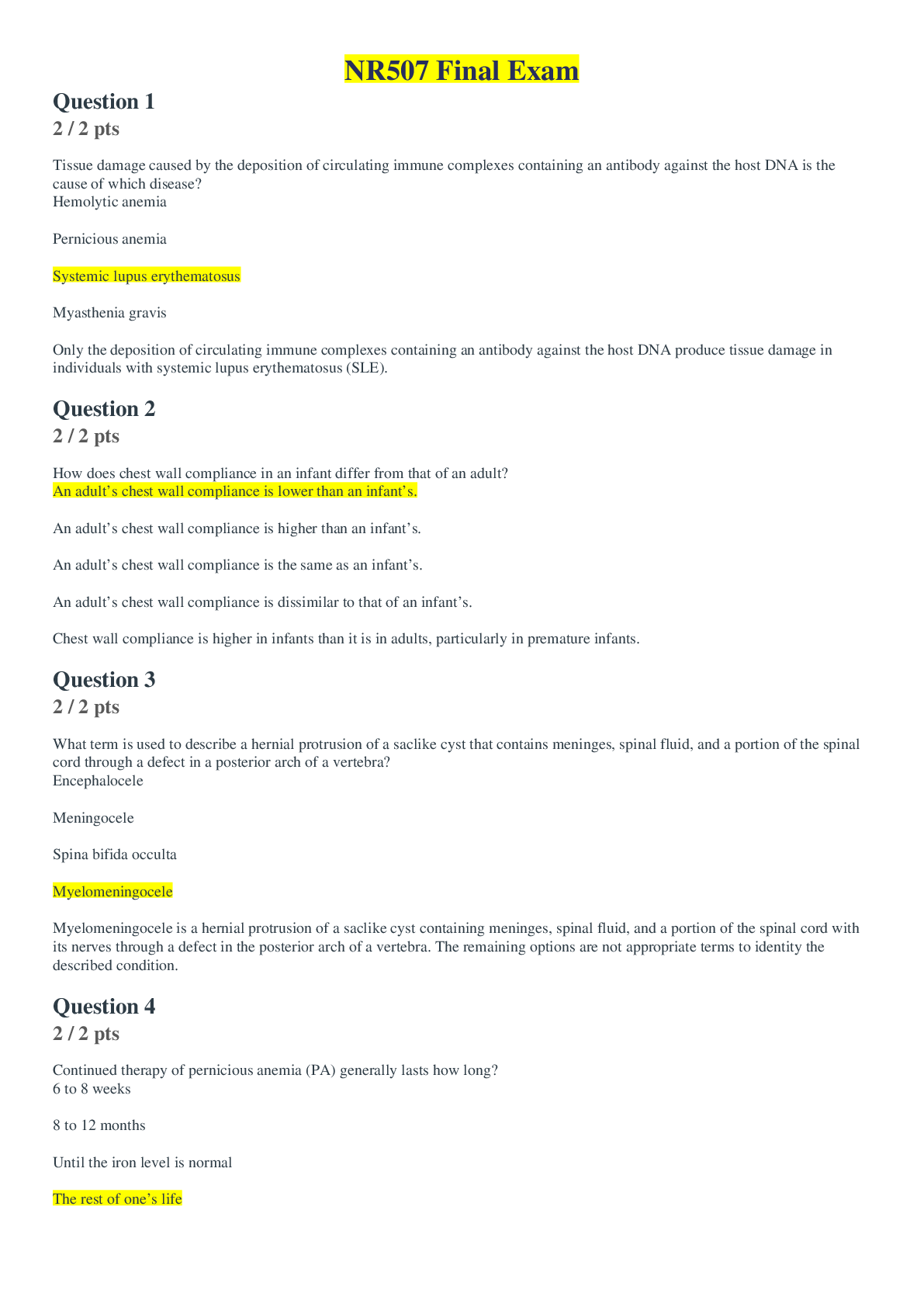

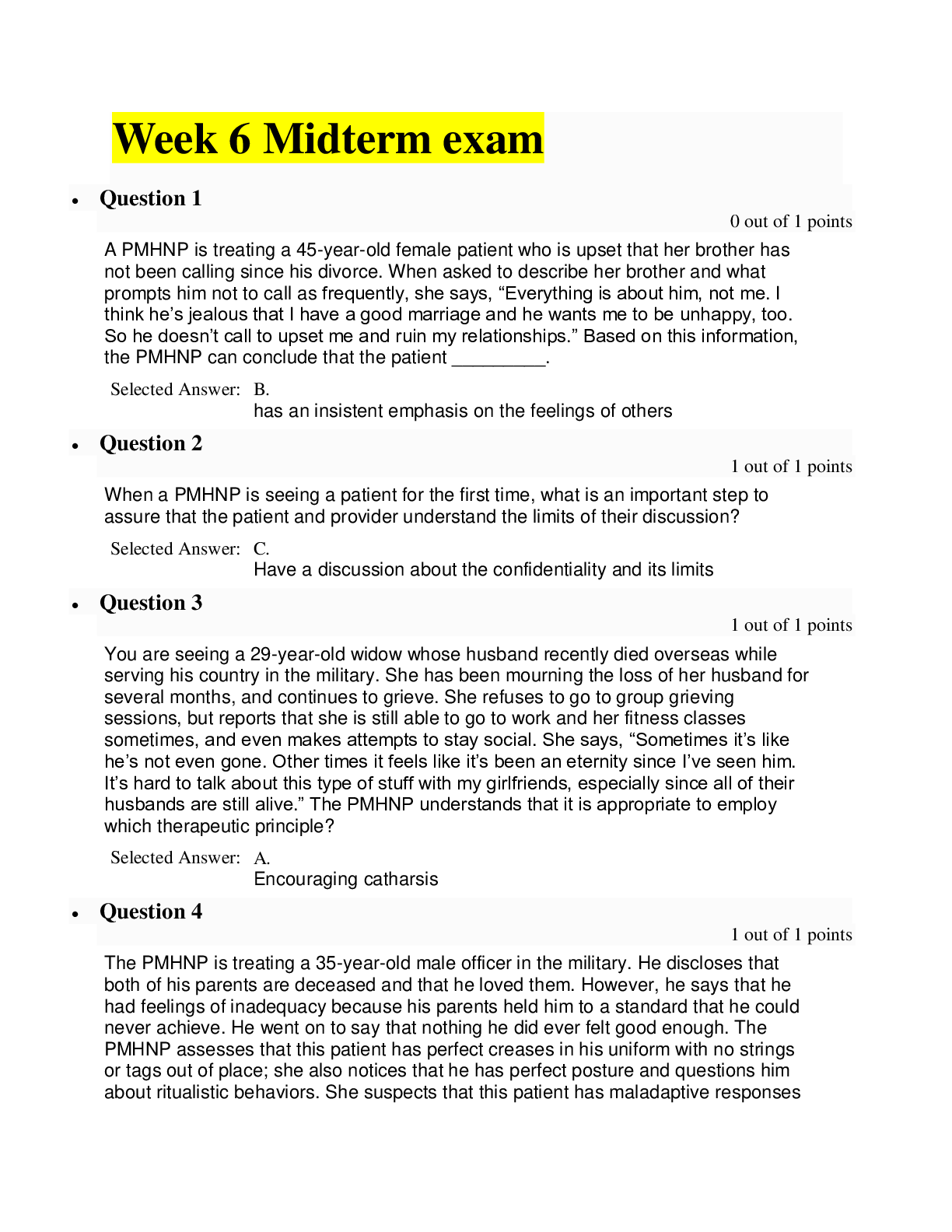

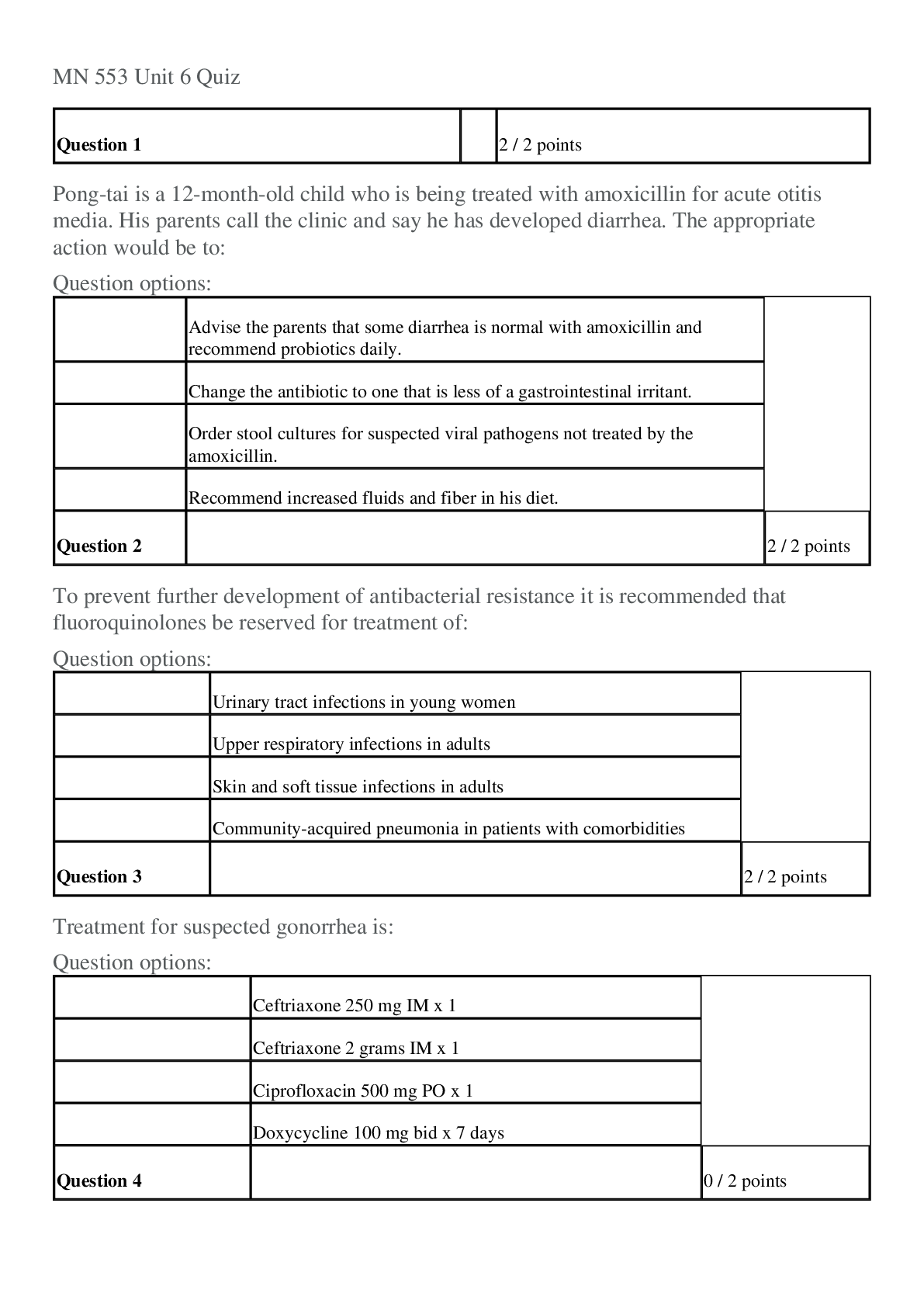


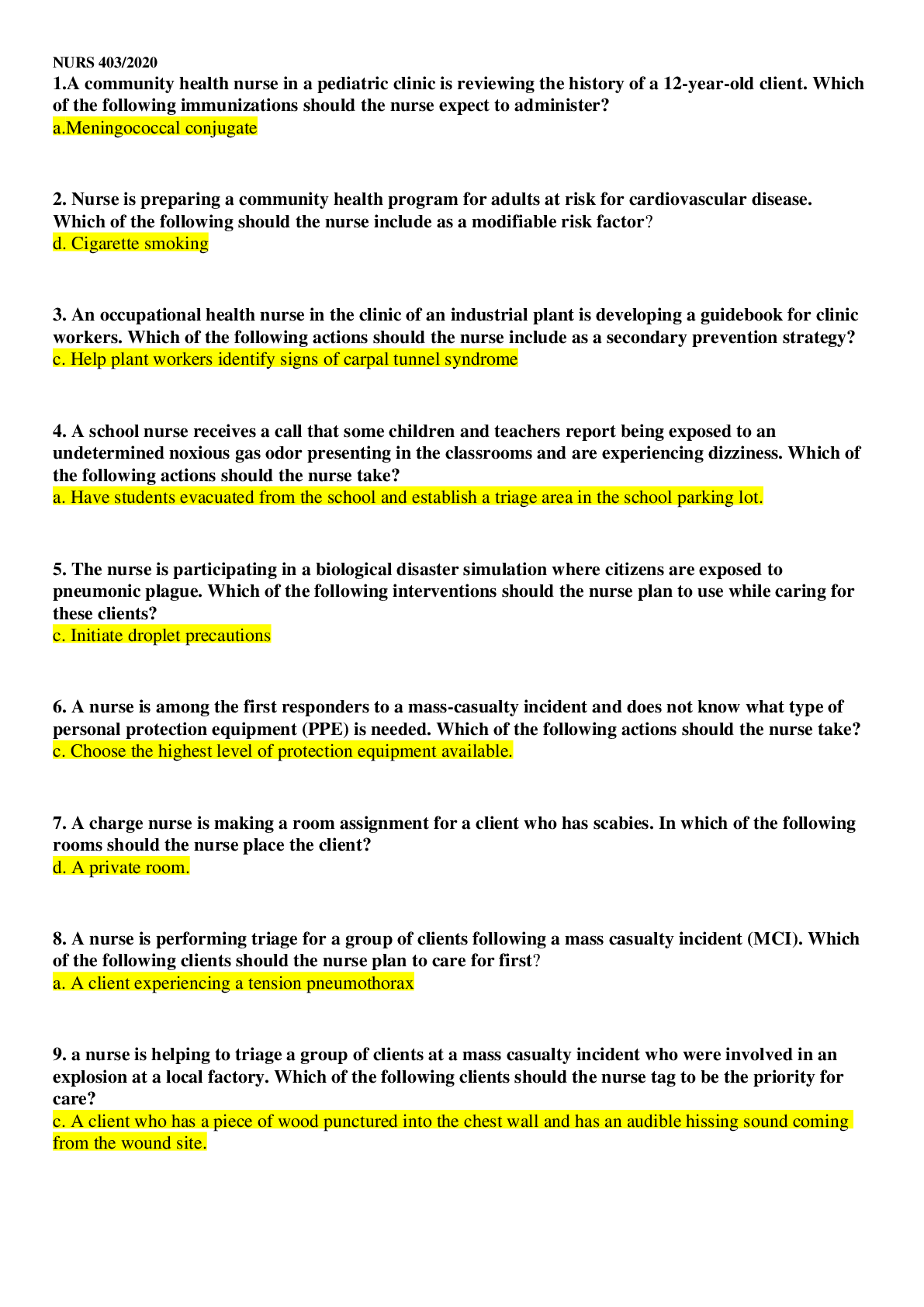

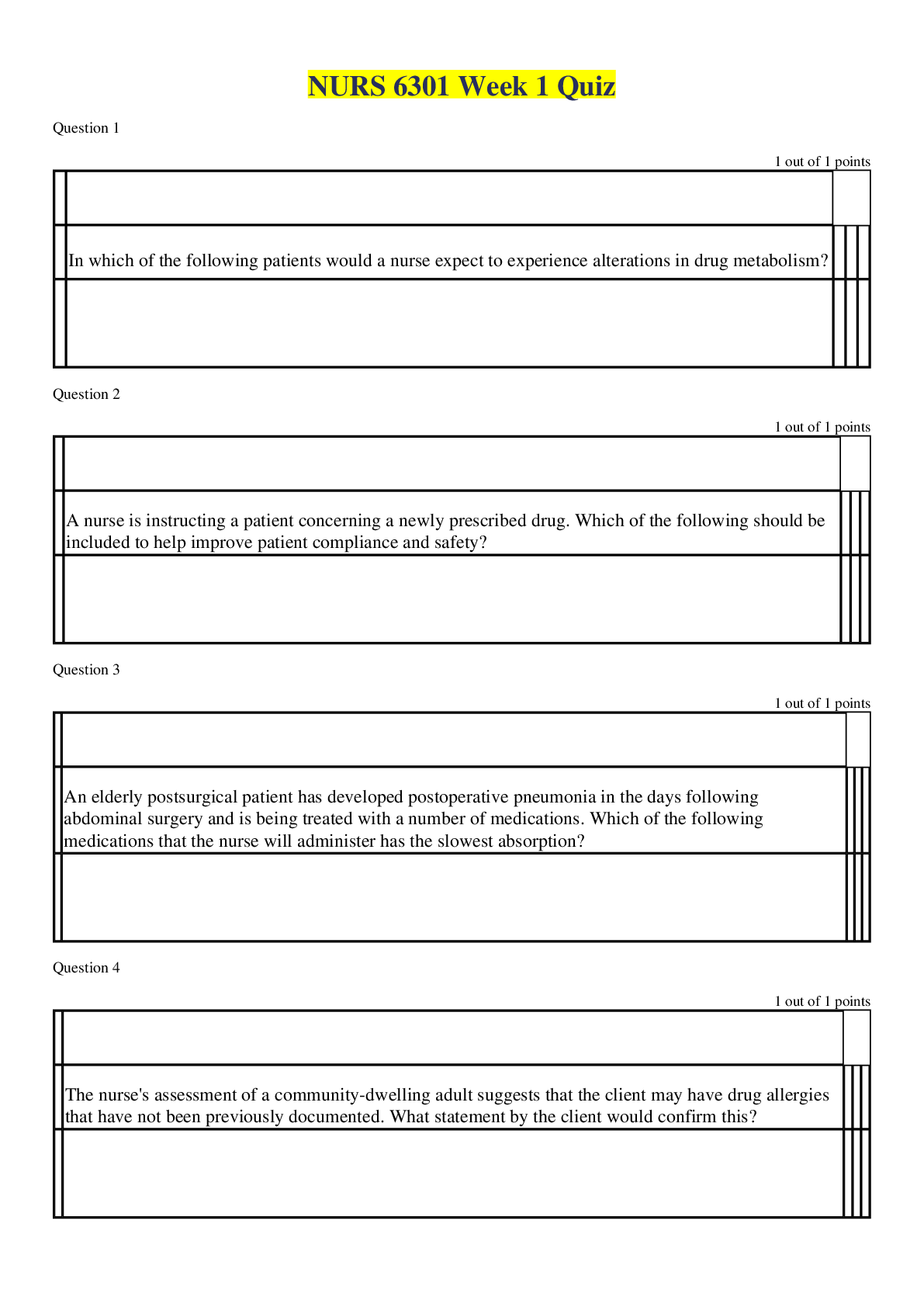
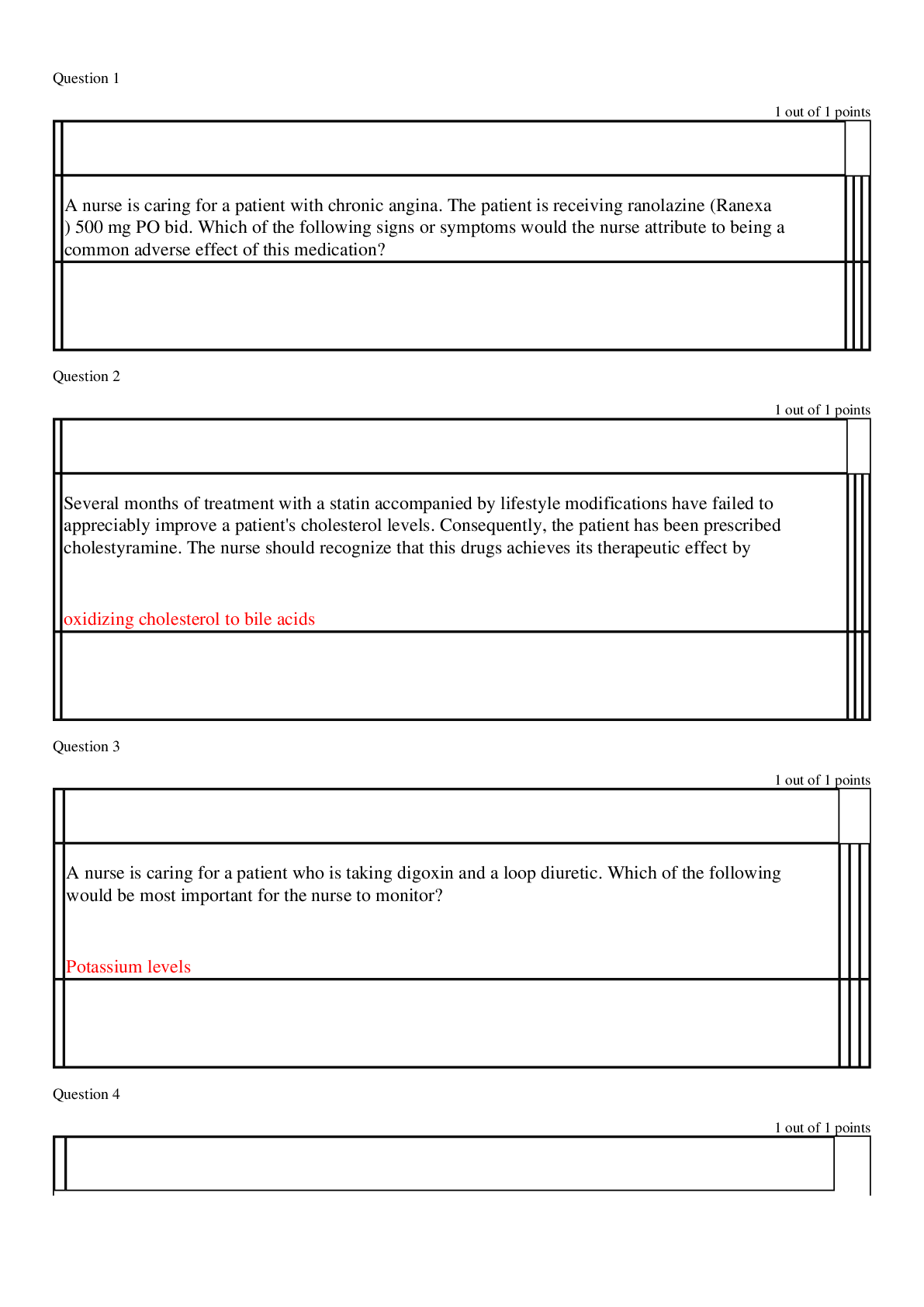

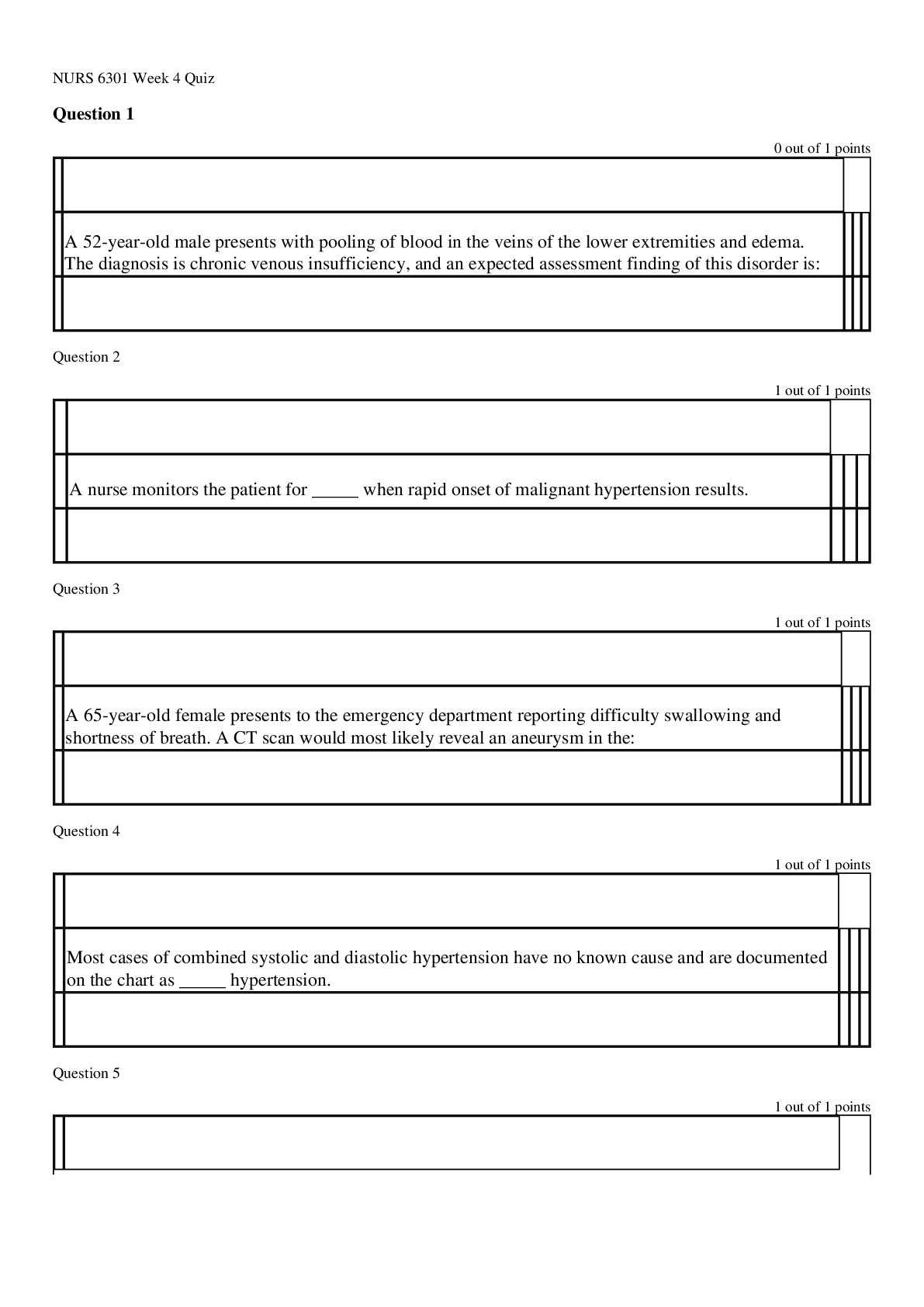
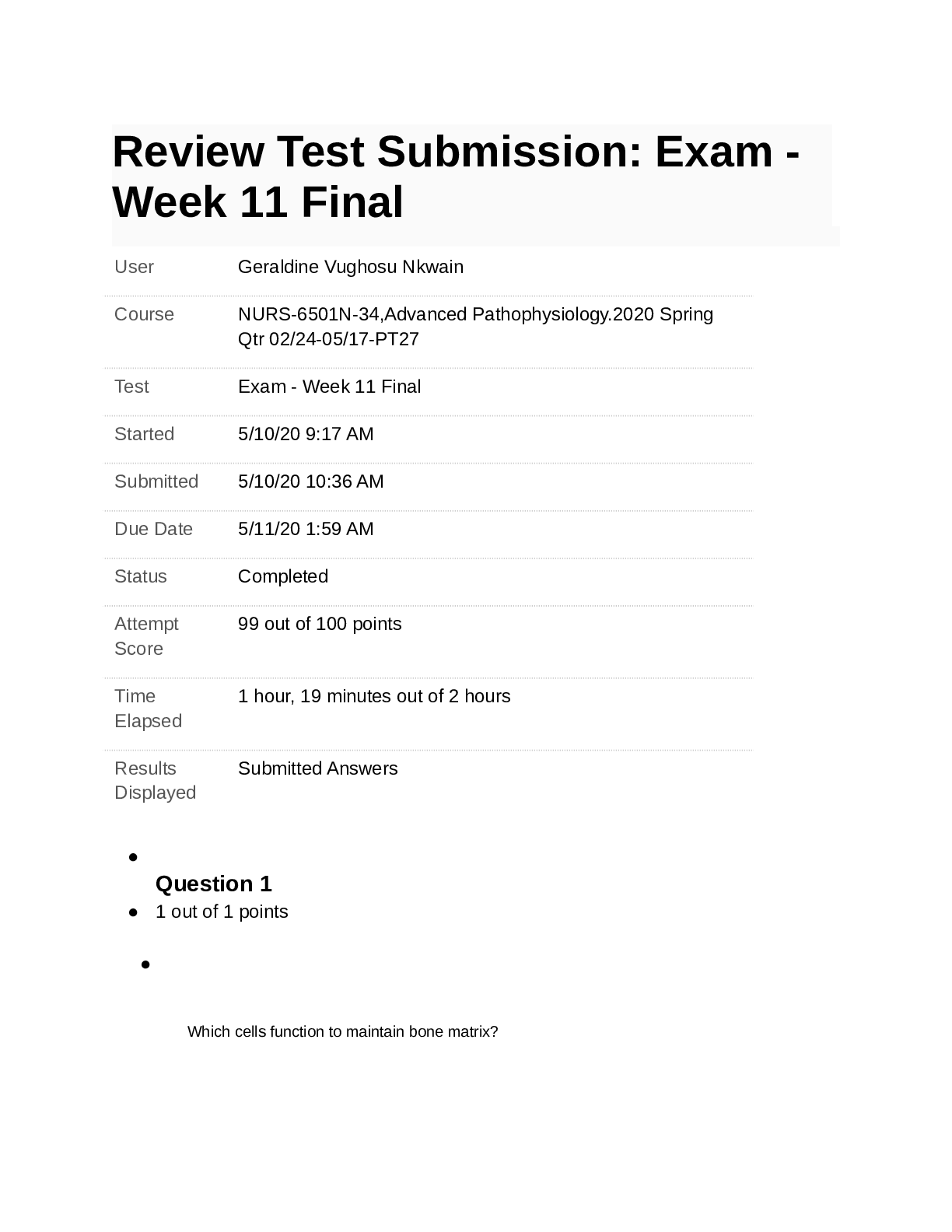

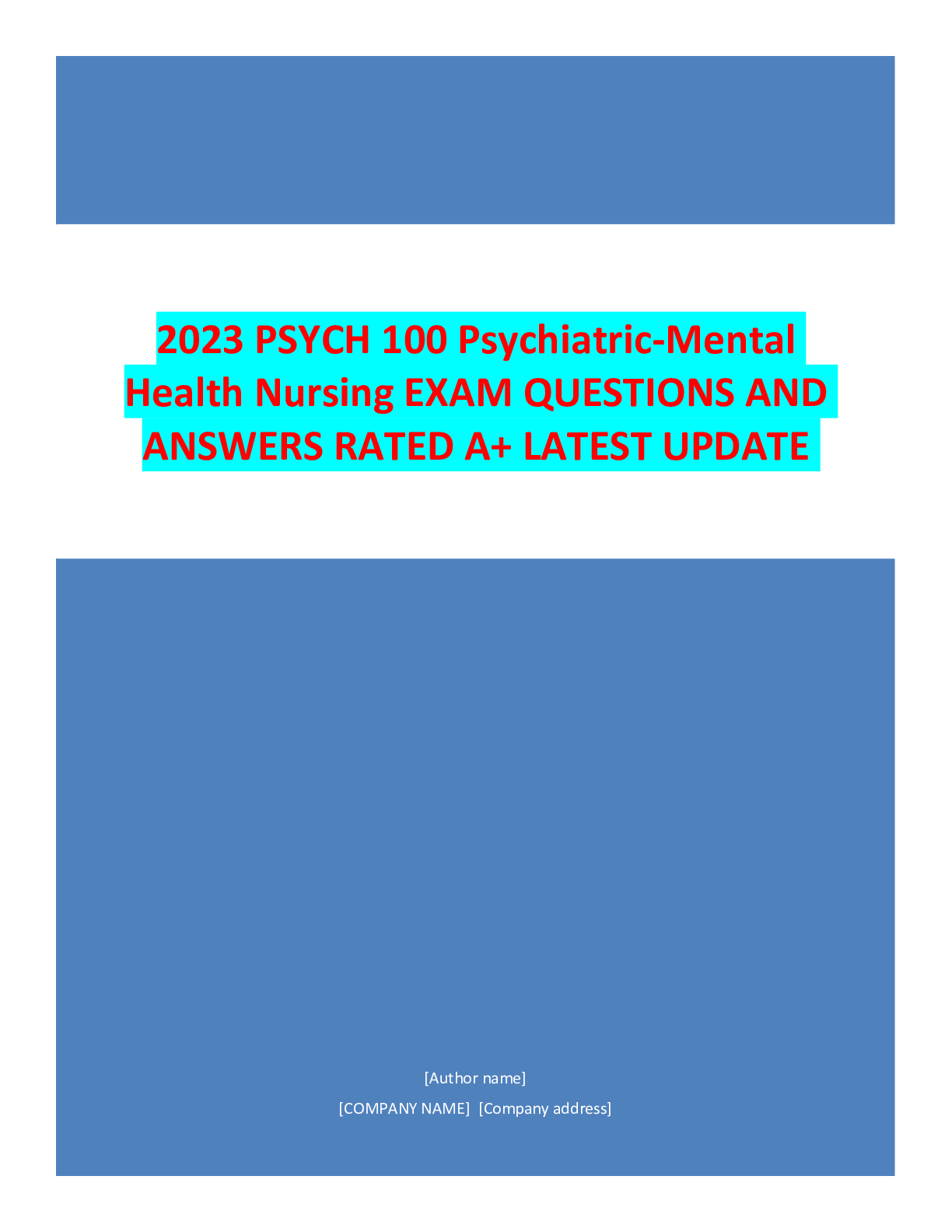
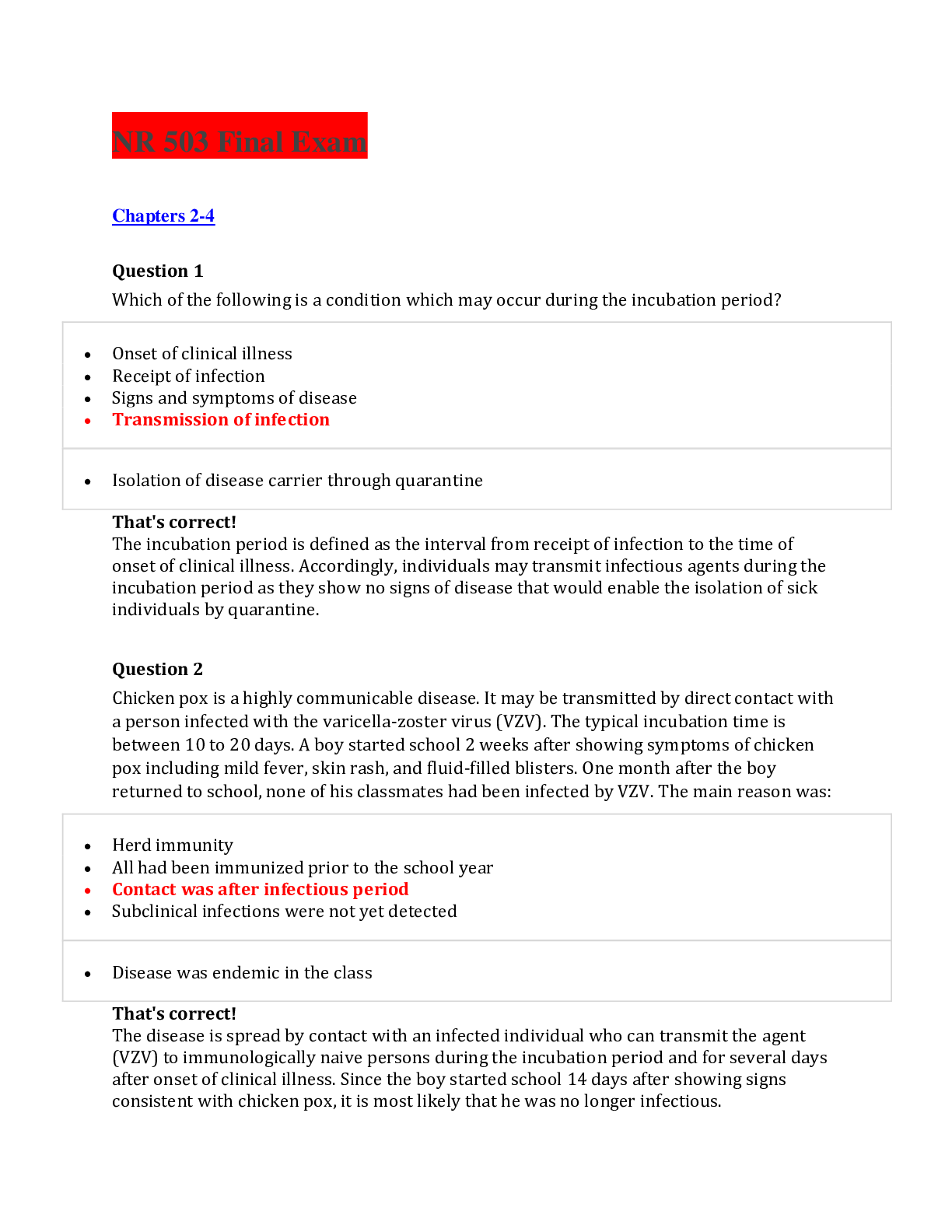




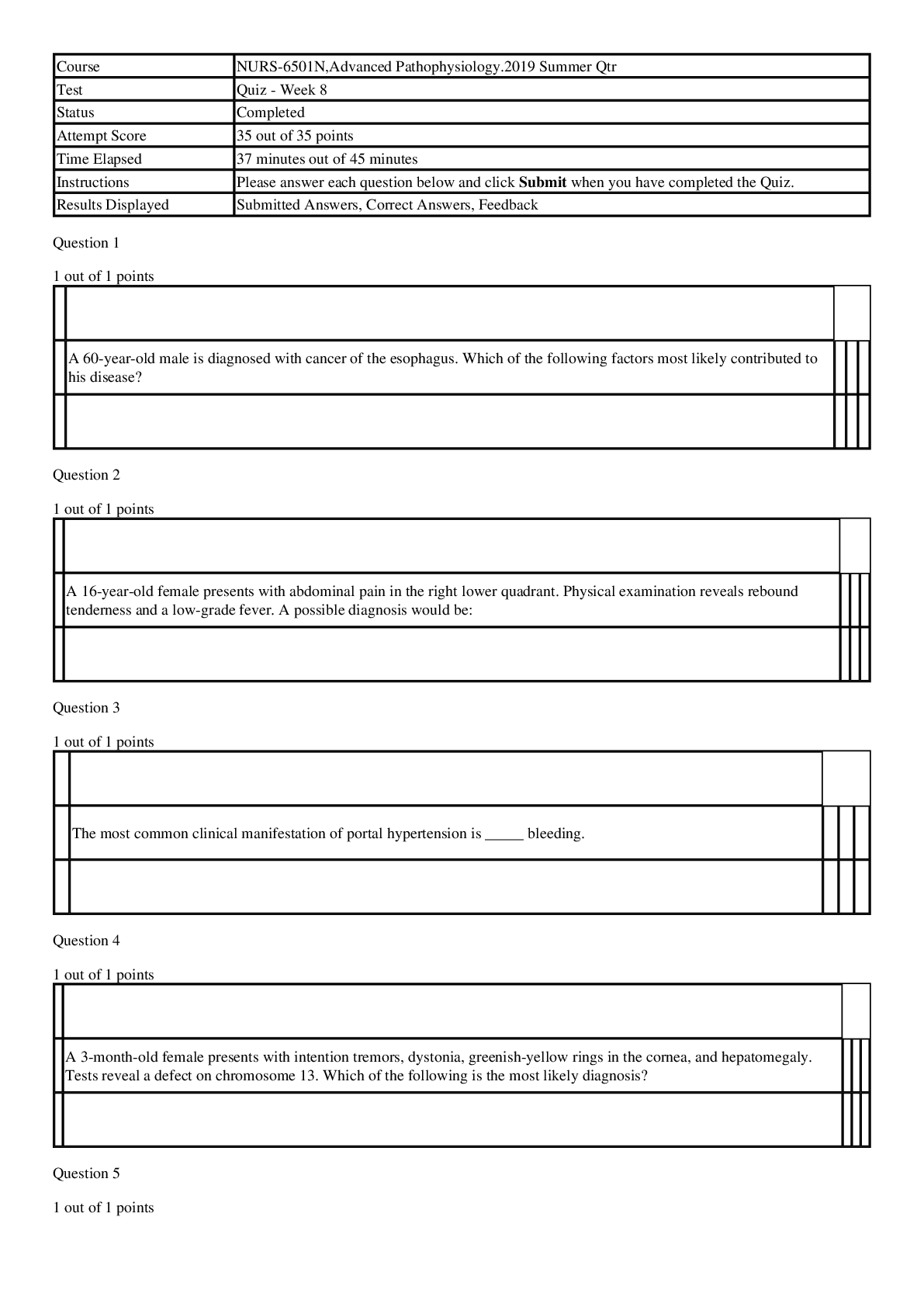
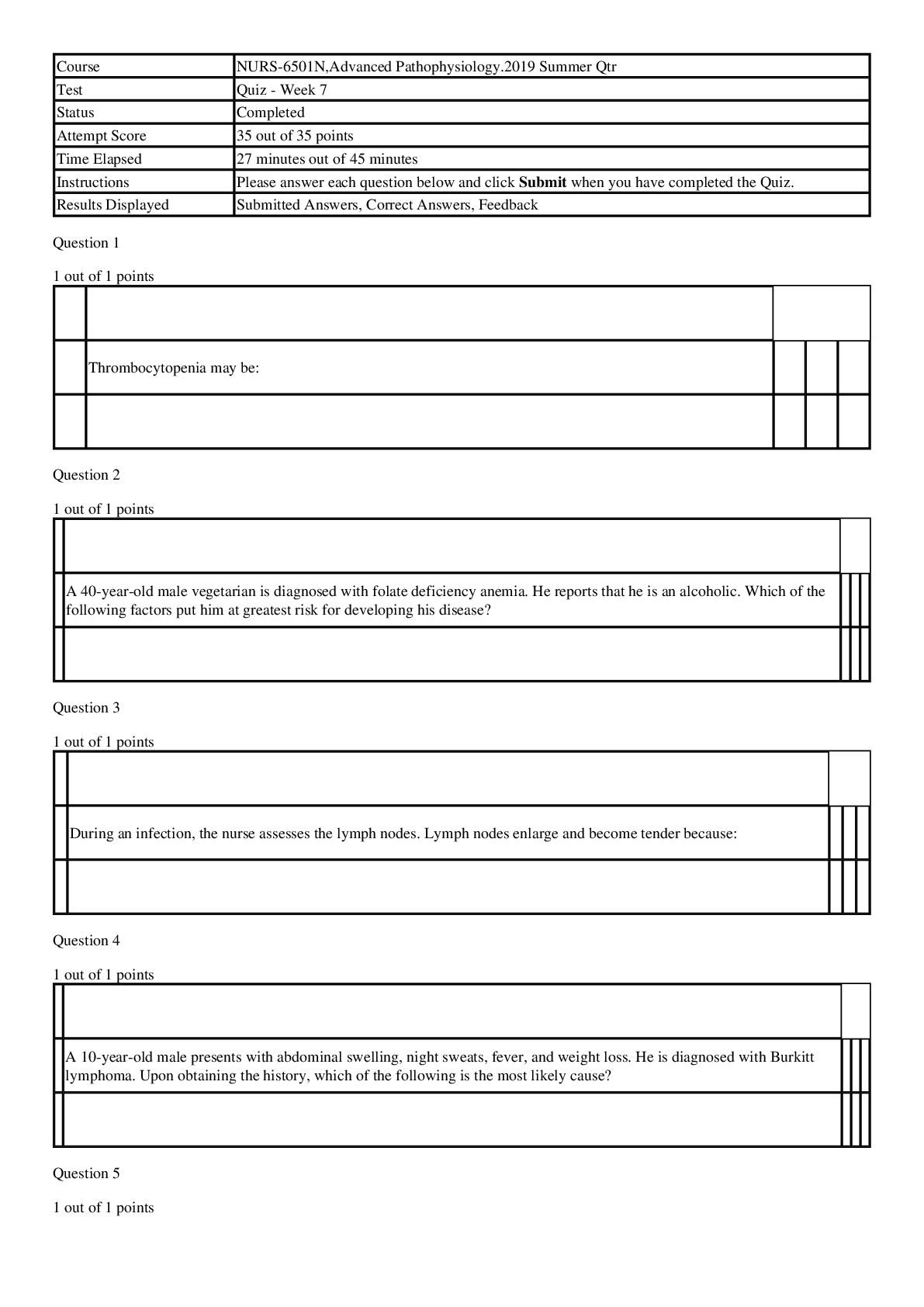
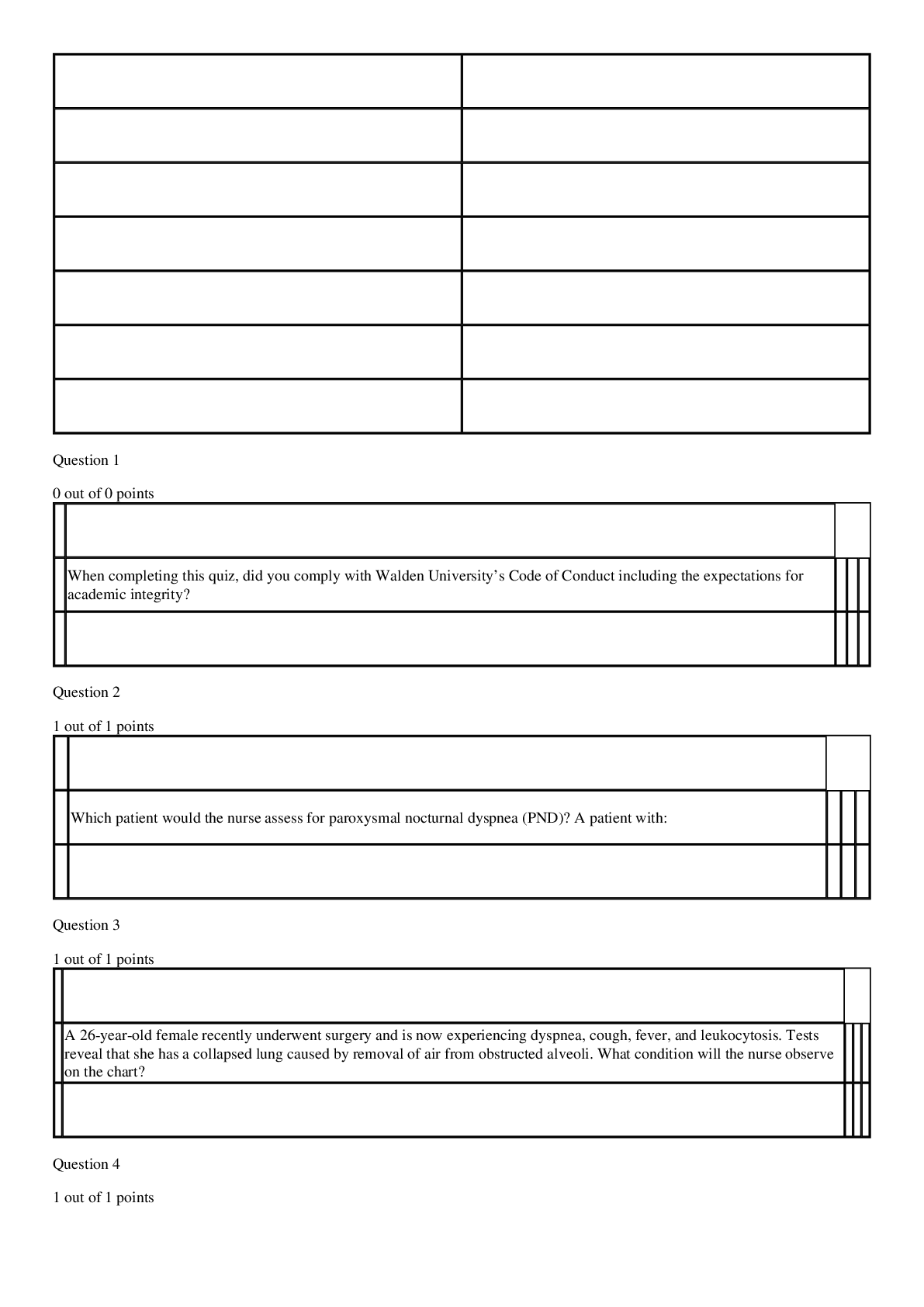
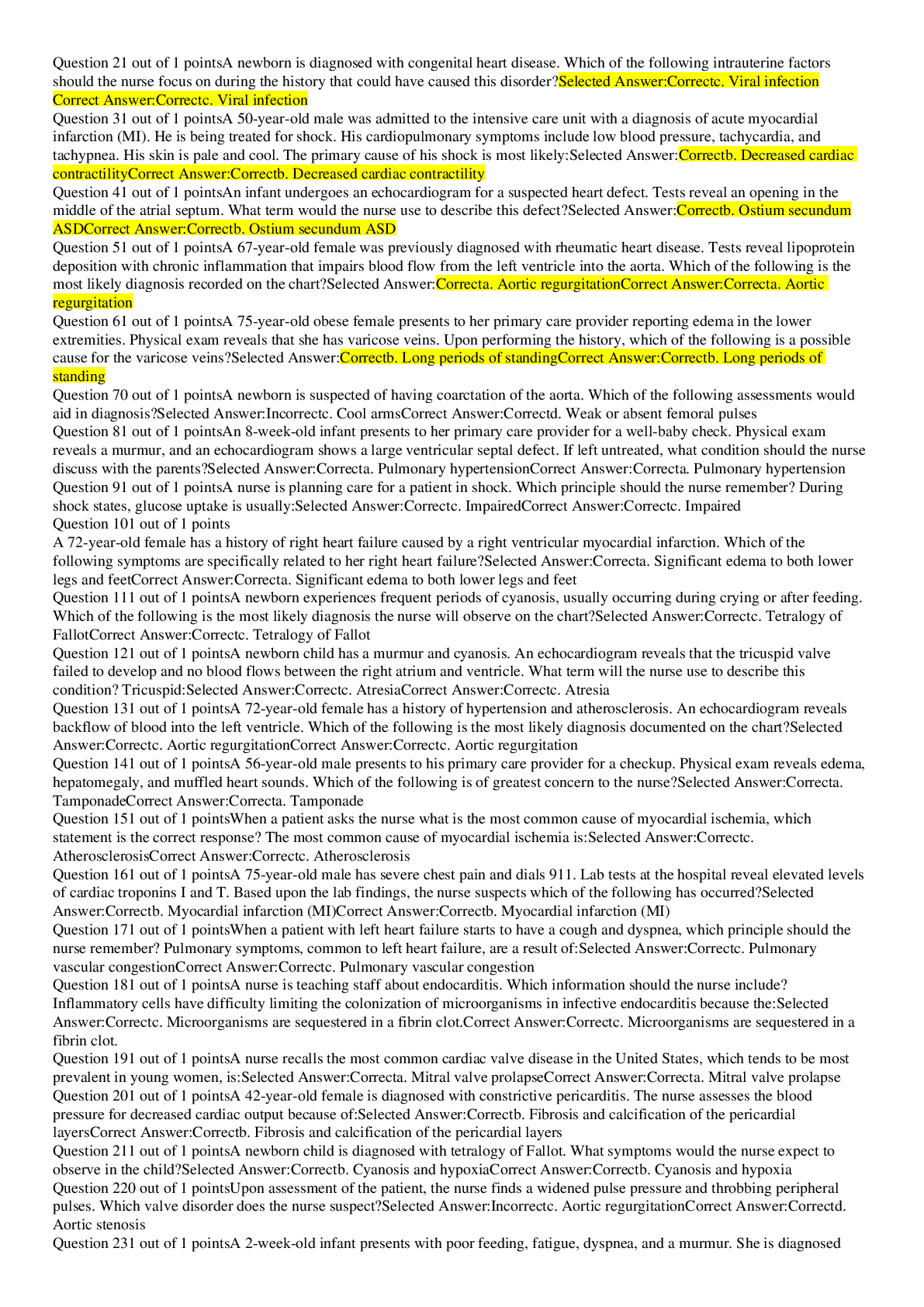
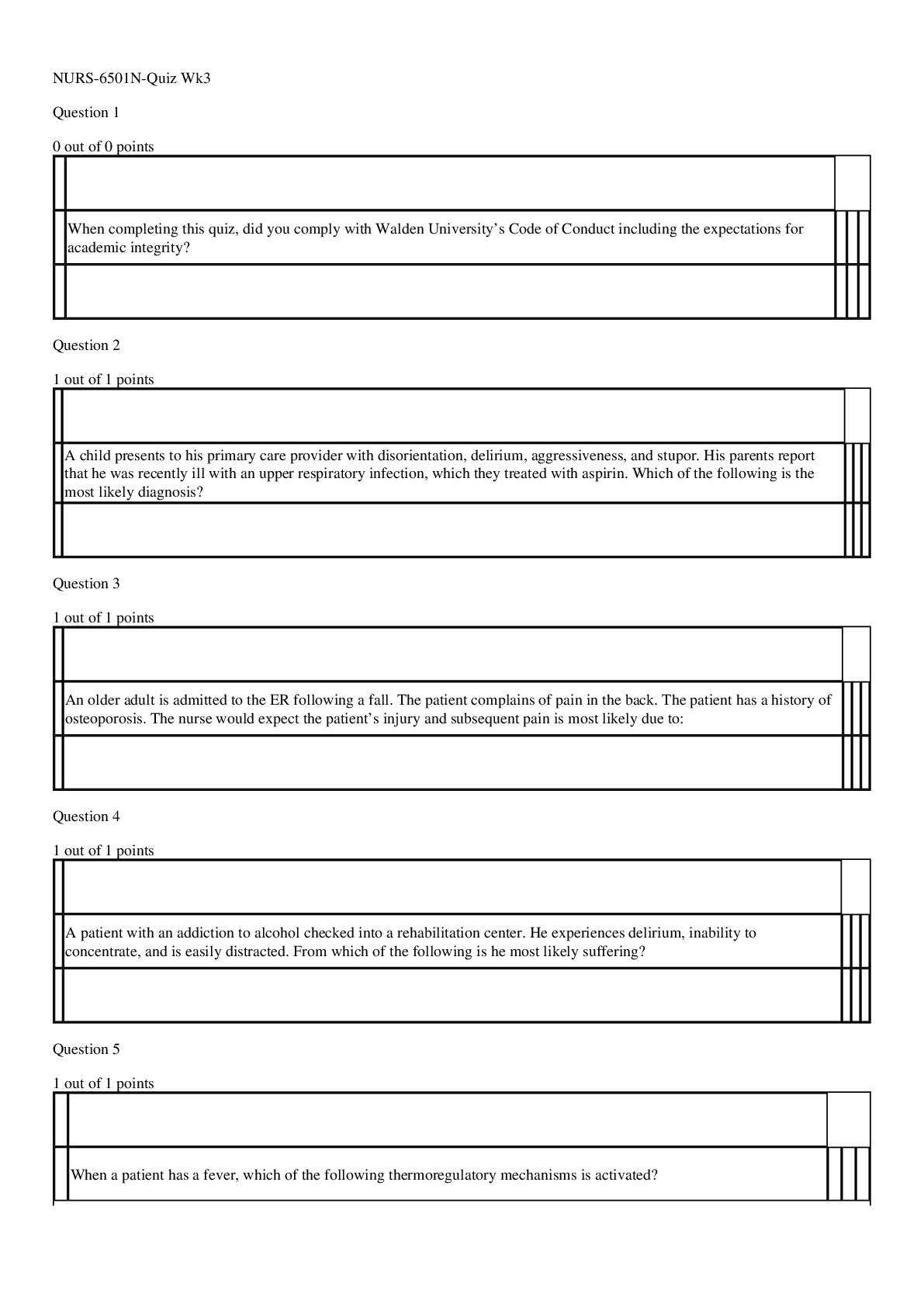
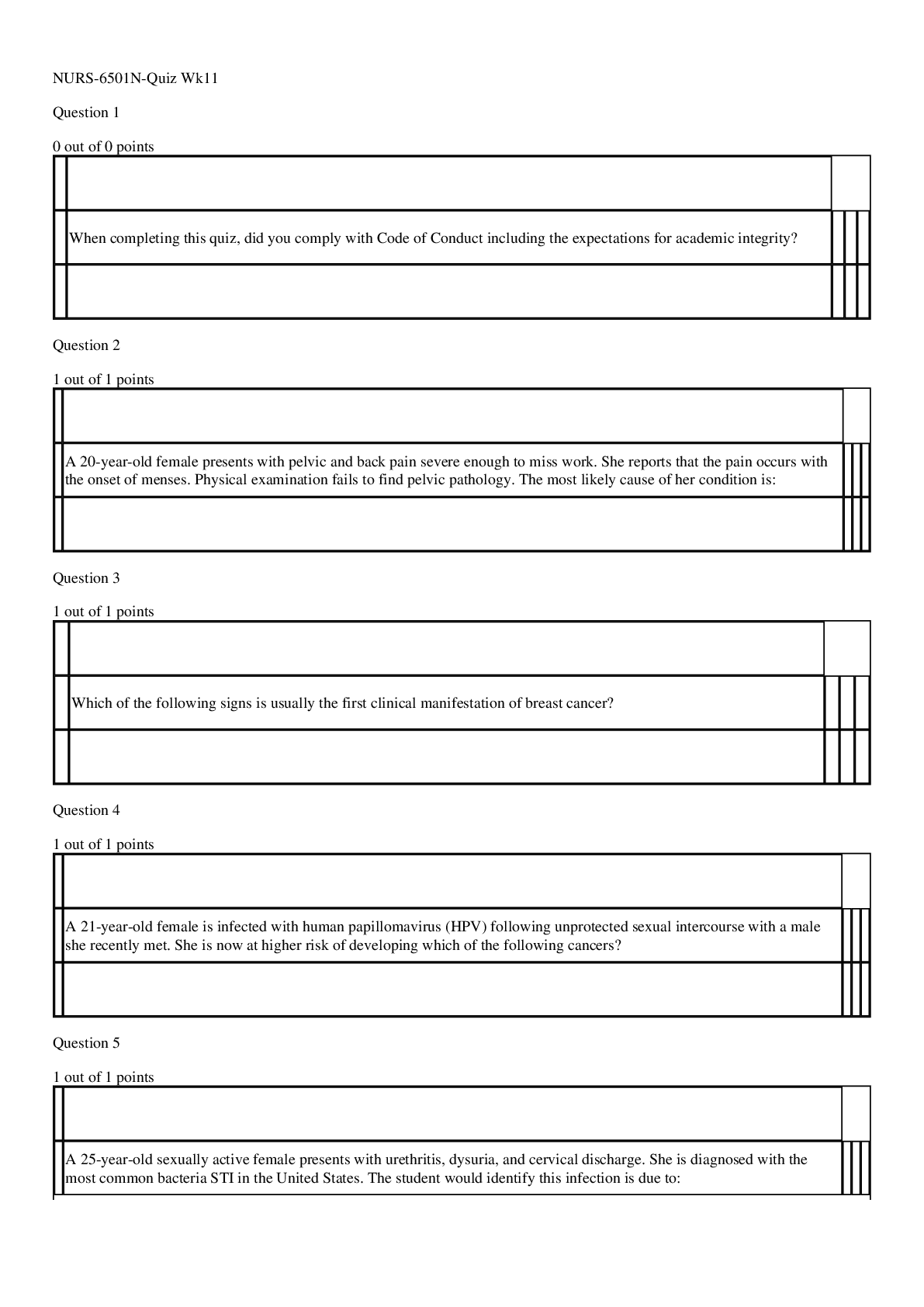
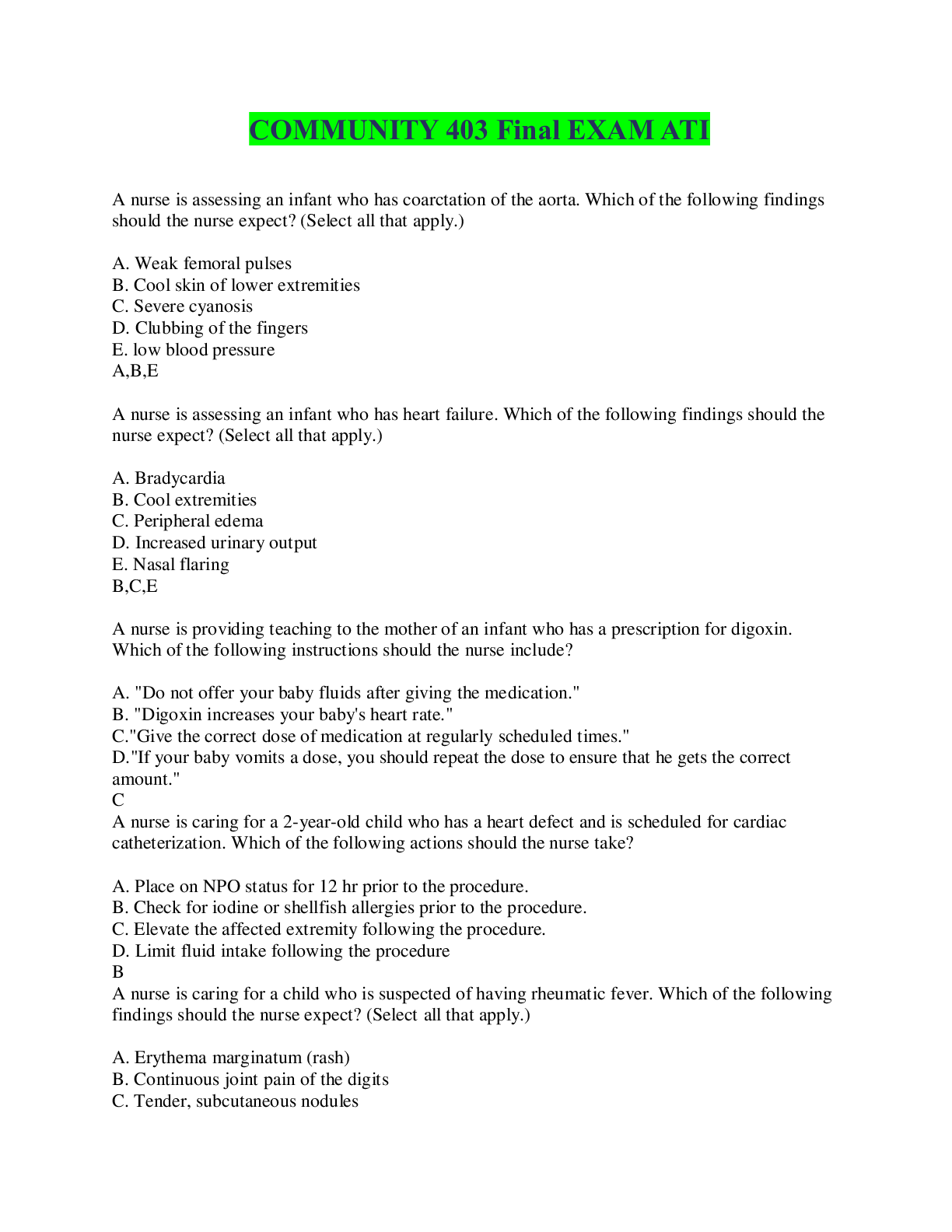
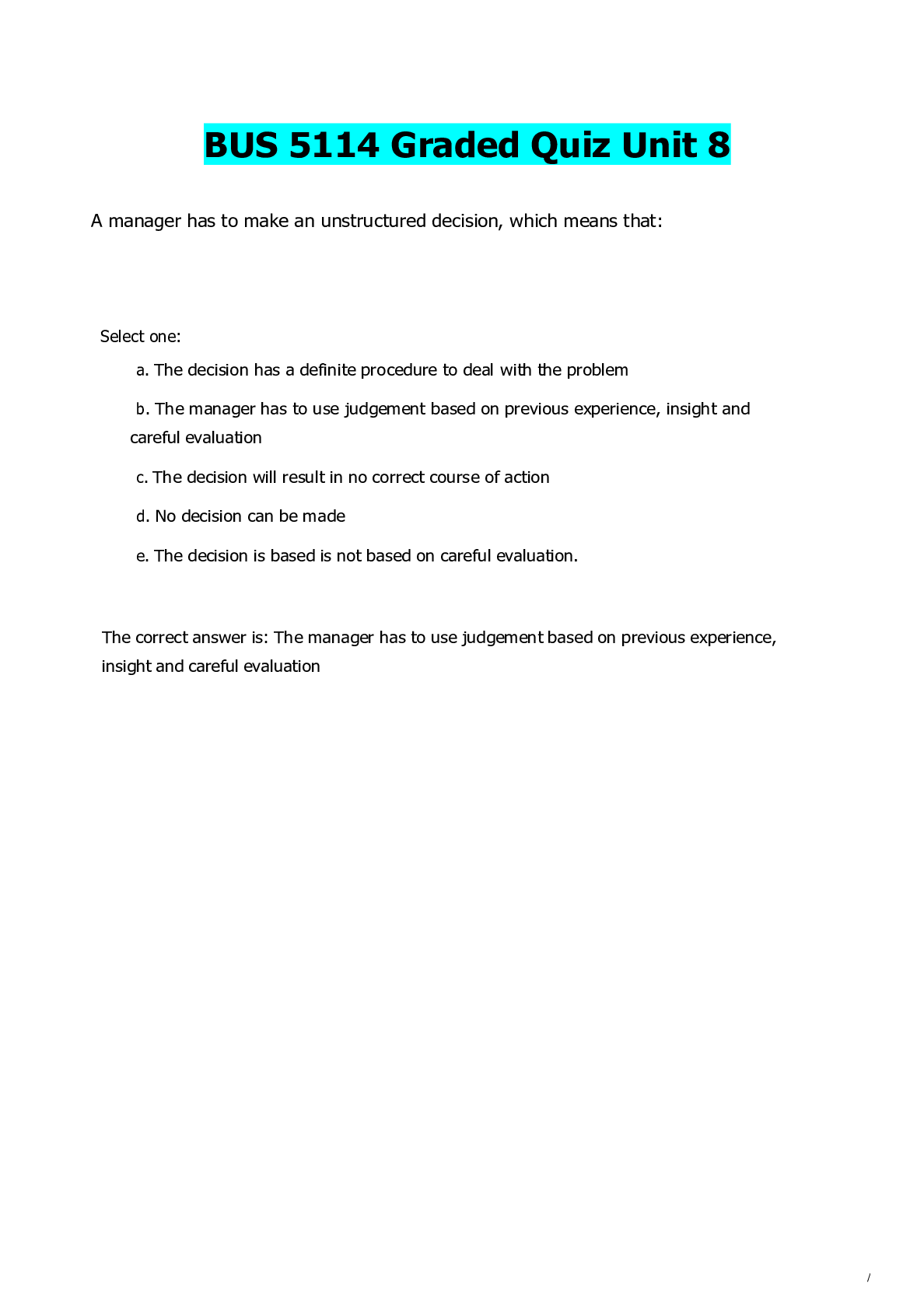
.png)
